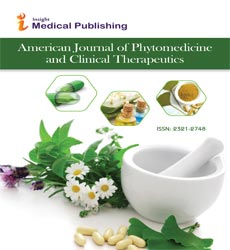ISSN : 2321-2748
American Journal of Phytomedicine and Clinical Therapeutics
Searching the Hidden Potential of an Underrated Plant
Sanjib Das*
Department of Zoology, University of Burdwan, West Bengal, India
- *Corresponding Author:
- Sanjib Das
Department of Zoology, University of Burdwan, West Bengal,
India,
E-mail: sanjib.das@gmail.com
Received date: July 16, 2024, Manuscript No. IPAPCT-24-19576; Editor assigned date: July 19, 2024, PreQC No. IPAPCT-24-19576 (PQ); Reviewed date: August 02, 2024, QC No. IPAPCT-24-19576; Revised date: August 09, 2024, Manuscript No. IPAPCT-24-19576 (R); Published date: August 16, 2024, DOI: 10.36648/2321-2748.12.02.288
Citation: Das S (2024) Searching the Hidden Potential of an Underrated Plant. Am J Phytomed Clin Ther Vol. 12 No.02: 288.
Description
The Scadoxus multiflorus is an ornamental, ethnomedicinal plant of the genus Scadoxus (Amaryllidaceae family). The species has a large number of traditional practices such as in the treatment of fever, cough, gastrointestinal problems and wound healing. Finding studies that provide the scientific validation of the traditional uses, focusing on the geographical distributions to provide information on the global availability of this popular ornamental plant that is very common to Africa to increase the research interest, documenting the major phytoconstituents and their extraction procedures, various pharmacological activities, critical analysis of the research interest on the plant and current scenario with intense analysis of research gaps for future studies. The research was conducted through google scholar, pubmed, web of science and science direct and included the scientific reports of 64 years.
Phytochemical and pharmacological insights
The entire process involved four phases in getting all the required information by using specific keywords (“Scadoxus”, “Scadoxus multiflorus”, “African poisonous plants” and “South African herbal medicine”) without any boolean operators. The search strategy is explained through. There are no specific review reports available on the traditional uses, phytochemistry under and pharmacology of the plant, along with a critical analysis of the current research status. In most of the cases, scientific knowledge is unavailable regarding traditional uses. The phytochemical investigations explored the presence of alkaloids, tannins, saponins, flavonoids, terpenoids, glycosides and carbohydrates from various parts of this plant. The pharmacological properties include antimicrobial, antioxidant, cytotoxic, acetylcholinesterase inhibition and so on. The plant is found all over the world and possesses a variety of pharmacological properties. The toxicity profile of this plant necessitates an immediate scientific investigation of its traditional uses. Extensive studies are required on the phytochemistry of the plant to isolate the bioactive compounds. In-depth studies of various biological activities, including in vivo and in vitro studies, are also required to determine their mechanisms of action. Therefore, this article presents a comprehensive review of the ethnomedicinal uses, phytochemistry and pharmacology of of Scadoxus multiflorus and enlightens the new pathways for further study for the first time
Exploring medicinal potential
The historical utilization of medicinal plants in traditional medicine has significantly contributed to the exploration and development of various pharmacologically active natural products Recent trends indicate that a substantial portion of commercially available drugs has stemmed from plant-derived natural compounds, resulting in an escalating global market for herbal products within the pharmaceutical industry Scadoxus multiflorus (Martyn) Raf. (syn. Haemanthus multiflorus Martyn) is an ornamental, rhizomatous, bulbous herb belonging to the Amaryllidaceae family. Originating from South Africa, it has now proliferated worldwide, with its sole representation in India within the genus Commonly known as blood lily, Chhatrapati, powderpuff lily, mayflower, inkuphulwana, African blood lily, fireball lily, torch lily, Catherine wheel and football lily. It is primarily recognized for its splendid, sizable flowers and bulbs, often traded as saplings ethnobotanical records extensively document its traditional uses, encompassing the treatment of various conditions such as colds, coughs, asthma, scabies, wounds, diarrhea, inflammation and dropsy scientific substantiation.
Comprehensive plant evaluation
While some research has explored the medicinal properties of S. multiflorus, the majority has concentrated on the phytochemistry and pharmacological activities of the bulb and roots Conversely, investigations into other parts, such as flowers, leaves and stems despite their extensive traditional usage remain limited. Recent studies on the leaves have revealed promising pharmacological properties but have also raised concerns regarding potential toxicity, highlighting the need for a deeper understanding of phytochemistry to discern bioactive compounds. In light of this, it is evident that comprehensive scientific validation is imperative for all traditional uses, particularly those of stems and flowers, which lack substantive scientific exploration. A thorough assessment of the toxicity of each plant part is necessary to determine the need for any usage restrictions. A recent comprehensive review on the genus "Scadoxus" highlighted the medicinal properties and toxicity ofvarious members, advocating for increased research efforts to differentiate between toxic effects and the bioactivities. Building on this review, our current study concentrated on S. multiflorus due to its widespread distribution, enabling global research opportunities compared to other regional species of the genus. Remarkably, despite its numerous pharmacological activities, there exists a dearth of prior literature accentuating the medicinal values of S. multiflorus beyond its ornamental significance, signifying an untapped potential for research in this plant. This lacuna motivated us to compile information on its ethno medicinal uses, phytochemical profile and pharmacology, aiming to illuminate the medicinal importance of this plant for the first time while identifying research gaps. This attempt not only highlights the current status of research interest in S.multiflorus but also delineates promising avenues for future investigations.

Open Access Journals
- Aquaculture & Veterinary Science
- Chemistry & Chemical Sciences
- Clinical Sciences
- Engineering
- General Science
- Genetics & Molecular Biology
- Health Care & Nursing
- Immunology & Microbiology
- Materials Science
- Mathematics & Physics
- Medical Sciences
- Neurology & Psychiatry
- Oncology & Cancer Science
- Pharmaceutical Sciences
